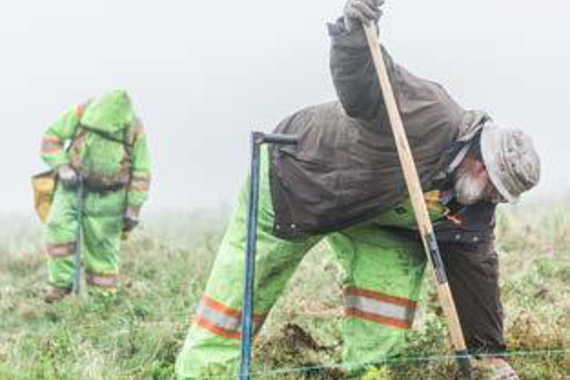
Volunteers plant white spruce seedling on the Skyline Trail as part of Bring Back the Boreal restoration project. Photo: © Nadine Lefort
Bring back the boreal
Restoring forest health to Cape Breton Highlands National Park
What’s the issue?

By the 1920s, moose and wolves had disappeared from Cape Breton Island as a result of European hunting and settlement. In the 1940s, moose were reintroduced and the new population took hold. Thirty years later, a spruce budworm outbreak – a natural disturbance in boreal forests – killed mature trees, but was so massive in scale it made way for an unprecedented amount of succulent new growth that moose prefer. A lack of natural predators, combined with low levels of hunting meant the moose thrived and the ecosystem suffered; moose ate young trees before they could mature, leaving behind fields instead of forests. A myriad of species in Cape Breton Highland National Park have been affected, including the threatened Bicknell’s thrush, which depends on forests to survive. Particularly hard hit is North Mountain, where grassland now covers two thirds of an area once forested. Biodiversity has been disrupted in an area where the Mi’kmaw people have been stewards of these lands since time immemorial.
What’s our approach?
- Work with Mi’kmaw partners to find sustainable solutions to restore the boreal forest.
- Encourage natural forest regeneration by reducing the moose population.
- Monitor browse on regenerating balsam fir and white birch.
- Construct moose exclosure to protect balsam fir seedlings and create Bicknell’s thrush habitat.
- Increase density of white spruce and balsam fir to more than 7,000 stems per hectare to support Bicknell’s thrush.
What’s been accomplished?
- Maintained moose-reduction partnership with the Mi’kmaq of Nova Scotia.
- Reduced North Mountain moose population by more than 60 percent annually; decreased browse impacts on North Mountain.
- Constructed a 5-hectare exclosure on Skyline Trail (2015) featuring interpretive panels, a viewing platform and a webcam enjoyed by more than 25,000 visitors in its first year.
- Planted 57,000 white spruce and balsam fir seedlings (2015–2017); achieved 3.4 hectares with more than 7,000 stems per hectare for Bicknell’s thrush.
- Recruited 2,700 volunteers, including students and Mi’kmaw youth.
- Produced videos (video 1, video 2) to share project details with the public.
- Date modified :